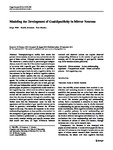Modeling the development of goal-specificity in mirror neurons
| dc.contributor.author | Thill, Serge | |
| dc.contributor.author | Svensson, H | |
| dc.contributor.author | Ziemke, T | |
| dc.date.accessioned | 2018-12-12T12:18:09Z | |
| dc.date.available | 2018-12-12T12:18:09Z | |
| dc.date.issued | 2011 | |
| dc.identifier.issn | 1866-9956 | |
| dc.identifier.issn | 1866-9964 | |
| dc.identifier.other | 4 | |
| dc.identifier.uri | http://hdl.handle.net/10026.1/13023 | |
| dc.description | addendum: [OA] owner: teslar timestamp: 2010.05.10 | |
| dc.description.abstract |
Neurophysiological studies have shown that parietal mirror neurons encode not only actions but also the goal of these actions. Although some mirror neurons will fire whenever a certain action is perceived (goal-independently), most will only fire if the motion is perceived as part of an action with a specific goal. This result is important for the action-understanding hypothesis as it provides a potential neurological basis for such a cognitive ability. It is also relevant for the design of artificial cognitive systems, in particular robotic systems that rely on computational models of the mirror system in their interaction with other agents. Yet, to date, no computational model has explicitly addressed the mechanisms that give rise to both goal-specific and goal-independent parietal mirror neurons. In the present paper, we present a computational model based on a self-organizing map, which receives artificial inputs representing information about both the observed or executed actions and the context in which they were executed. We show that the map develops a biologically plausible organization in which goal-specific mirror neurons emerge. We further show that the fundamental cause for both the appearance and the number of goal-specific neurons can be found in geometric relationships between the different inputs to the map. The results are important to the action-understanding hypothesis as they provide a mechanism for the emergence of goal-specific parietal mirror neurons and lead to a number of predictions: (1) Learning of new goals may mostly reassign existing goal-specific neurons rather than recruit new ones; (2) input differences between executed and observed actions can explain observed corresponding differences in the number of goal-specific neurons; and (3) the percentage of goal-specific neurons may differ between motion primitives. | |
| dc.format.extent | 525-538 | |
| dc.format.medium | Print-Electronic | |
| dc.language | en | |
| dc.language.iso | en | |
| dc.publisher | Springer Science and Business Media LLC | |
| dc.subject | Mirror neurons | |
| dc.subject | Action-understanding hypothesis | |
| dc.subject | Computational model | |
| dc.subject | Neural activation patterns | |
| dc.subject | Self-organizing map | |
| dc.title | Modeling the development of goal-specificity in mirror neurons | |
| dc.type | journal-article | |
| dc.type | article | |
| plymouth.author-url | https://www.webofscience.com/api/gateway?GWVersion=2&SrcApp=PARTNER_APP&SrcAuth=LinksAMR&KeyUT=WOS:000297726000003&DestLinkType=FullRecord&DestApp=ALL_WOS&UsrCustomerID=11bb513d99f797142bcfeffcc58ea008 | |
| plymouth.issue | 4 | |
| plymouth.volume | 3 | |
| plymouth.publication-status | Published | |
| plymouth.journal | Cognitive Computation | |
| dc.identifier.doi | 10.1007/s12559-011-9108-1 | |
| plymouth.organisational-group | /Plymouth | |
| plymouth.organisational-group | /Plymouth/Faculty of Science and Engineering | |
| plymouth.organisational-group | /Plymouth/REF 2021 Researchers by UoA | |
| plymouth.organisational-group | /Plymouth/REF 2021 Researchers by UoA/UoA11 Computer Science and Informatics | |
| dc.publisher.place | United States | |
| dcterms.dateAccepted | 2011-08-26 | |
| dc.identifier.eissn | 1866-9964 | |
| dc.rights.embargoperiod | Not known | |
| rioxxterms.versionofrecord | 10.1007/s12559-011-9108-1 | |
| rioxxterms.licenseref.uri | http://www.rioxx.net/licenses/all-rights-reserved | |
| rioxxterms.type | Journal Article/Review |


